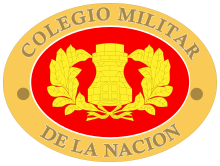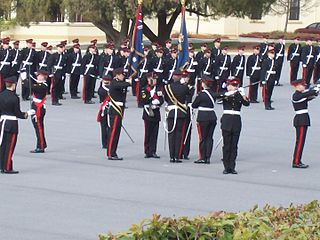
A military academy or service academy is an educational institution which prepares candidates for service in the officer corps. It normally provides education in a military environment, the exact definition depending on the country concerned.

Alejandro Agustín Lanusse was the de-facto president of the Argentine Republic between March 22, 1971, and May 25, 1973, during the military dictatorship of the country called the "Argentine Revolution".
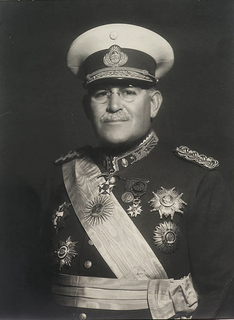
Agustín Pedro Justo Rolón was an Argentine military officer, diplomat and politician, who served as the president of Argentina from 1932 to 1938 during the Infamous Decade. Justo took part in the coup of 1930, becoming president two years later thanks to widespread electoral fraud. His presidency was part of the period known as the Infamous Decade, which lasted from 1930 until 1943. He established the country's central bank and introduced a nationwide income tax.
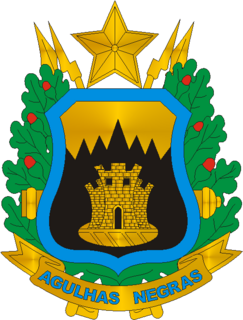
The Academia Militar das Agulhas Negras is the biggest among several schools of formation of combatant officers of the Brazilian Army. It originated in 1792 with the creation of the Royal Academy of Artillery, Fortification and Drawing, the first military school of the Americas, in the city of Rio de Janeiro. Today the Academy is located in the city of Resende, in the state of Rio de Janeiro.

The Battle of Caseros was fought near the town of El Palomar, Buenos Aires Province, Argentina, on 3 February 1852, between the Army of Buenos Aires commanded by Juan Manuel de Rosas and the Grand Army led by Justo José de Urquiza. The forces of Urquiza, caudillo and governor of Entre Ríos, defeated Rosas, who fled to the United Kingdom. This defeat marked a sharp division in the history of Argentina. As provisional Director of the Argentine Confederation, Urquiza sponsored the creation of the Constitution in 1853, and became the first constitutional President of Argentina in 1854.
El Palomar is a town in the urban agglomeration of Greater Buenos Aires in Argentina. It is located 20 km (12 mi) north-west of the Buenos Aires.
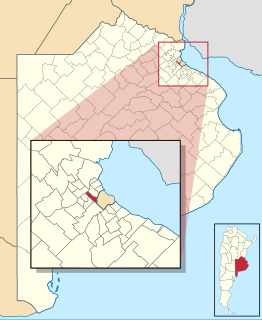
Tres de Febrero is a partido of the Greater Buenos Aires conurbation area in the Buenos Aires Province, Argentina.
Colégio Militar is a military secondary school in Lisbon, Portugal.
Ciudad Jardín Lomas del Palomar is a planned community, part of the partido of Tres de Febrero in Greater Buenos Aires and adjacent to the city of El Palomar. It is served by two railway lines, the San Martín Line and the Urquiza Line, which provide access to the capital about 20 kilometres (12 mi) away.
Campo de Mayo is a military base located in Greater Buenos Aires, Argentina, 30 km (19 mi) northwest of Buenos Aires.

The Heroic Military College is the major military educational institution in Mexico. It was founded in 1823 and located in the former Palace of the Inquisition in Mexico City. Initially designated as the Cadet Academy, it was renamed in 1823 as the Colegio Militar. The college was relocated in Perote, Veracruz, before being returned to Mexico City, where it was established in the Betlemitas monastery. From 1835, the Military College was located in the Recogidas Building. Cadets training for the Mexican Navy originally formed part of the student body, but in 1897, the Military Naval School was established as a separate institution in Veracruz.
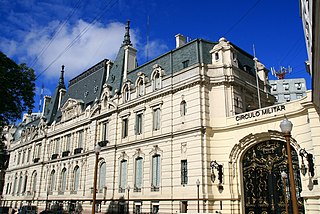
The Paz Palace is a former mansion in Buenos Aires, Argentina, housing the Military Officers' Association, a social club maintained by the Argentine military.

The so-called Ejército Grande, also called the Ejército Grande Aliado Libertador, was the coalition army that in 1852, under the command of the governor of Entre Ríos, Justo José de Urquiza, invaded the provinces of Santa Fe and Buenos Aires and defeated Juan Manuel de Rosas's army, which until that moment was in command of the foreign relations of the Argentine Confederation.

Ángel Pacheco, was an Argentine military officer trained by José de San Martín who later became one of the top commanders in the Confederacy during the dictatorship of Juan Manuel de Rosas. He never lost a battle under his command.

The Battle of Quebracho Herrado, fought on 28 November 1840 in the east of Córdoba Province, Argentina, was a victory for the Argentine federal army, led by former Uruguayan president, Brigadier Manuel Oribe over the Unitarian army led by Brigadier Juan Lavalle, during the Argentine Civil Wars.
Saturnino Canaveri was an Argentine military man and politician, who served as officer of the 2nd Cavalry Regiment. He took part in the main military actions that occurred during the Conquest of the Desert, including the actions prior to the Battle of Aluminé, against the Chilean Army.

For more than a century the Military Parade of Chile or Great Military Parade of Chile has been a tradition within the Independence Day holidays in Chile. It is held in Santiago, Chile's O'Higgins Park on September 19 yearly in honor of the Glories of the Chilean Army with a military parade involving not just the ground forces but by the rest of the Chilean Armed Forces: the Chilean Navy, the Chilean Air Force, and the Carabineros de Chile. It is also in honor of the anniversary of the formal inauguration on that day in 1810 of the First Government Junta, which witnessed the first military parade of the independent nation at the Plaza de Armas, Santiago. It is the final act of the national independence celebrations, which are broadcast through TV and the Internet and radio.

Héctor Canavery was an Argentine politician and military man, who took part in the military campaigns in the territory of Patagonia. He also dabbled in politics, serving as a legislator for the National Autonomist Party.

Pedro Leandro Zanni was a pioneering Argentinian pilot of the early 20th century who made the then longest west-to-east flight in a non-amphibious aircraft in his circumnavigation attempt of 1924.

General de División Juan Martín Paleo is an Argentine General who serves as the incumbent Chief of the Joint Chiefs of Staff of the Armed Forces of the Argentine Republic. Prior to his appointment, he served as the commander of the Rapid Deployment Force of the Argentine Army.
